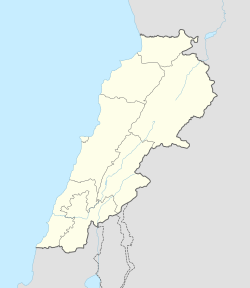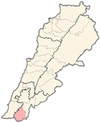
A | B | C | D | E | F | G | H | CH | I | J | K | L | M | N | O | P | Q | R | S | T | U | V | W | X | Y | Z | 0 | 1 | 2 | 3 | 4 | 5 | 6 | 7 | 8 | 9
Bint Jbeil
بنت جبيل | |
|---|---|
Village | |
 | |
| Coordinates: 33°07′15″N 35°26′1″E / 33.12083°N 35.43361°E | |
| Grid position | 190/280 PAL |
| Country | |
| Governorate | Nabatieh Governorate |
| District | Bint Jbeil District |
| Area | |
| • Total | 9.10 km2 (3.51 sq mi) |
| Elevation | 700 m (2,300 ft) |
| Population (2001) | |
| • Total | 30,000 |
Bint Jbeil (Arabic: بنت جبيل, romanized: Bint Jubayl; Levantine pronunciation: [bɪnt ʒbeːl], "daughter of (the) little mountain" or "daughter of Byblos") is the second largest town in the Nabatiye Governorate in Southern Lebanon.
The town has an estimated population of 30,000. Its exact population is unknown, because Lebanon has not conducted a population census since 1932.[1]
The town is considered "Hezbollah's capital in the south".[2][3]
History
Ottoman era

In 1596, it was named as a village, "Bint Jubayl" in the Ottoman nahiya (subdistrict) of Tibnin under the liwa' (district) of Safad, with a population of 238 households and 60 bachelors, all Muslim. The villagers paid taxes on agricultural products, such as wheat, barley, olive trees, fruit trees, goats and beehives, in addition to "occasional revenues", a press for olive oil or grape syrup, and a fixed sum; a total of 25,220 akçe.[4][5]
In 1838 Edward Robinson noted it as a large Shia village,[6] while in 1875, Victor Guérin found it to be a village with one thousand Metualis; based on archeological findings, he concluded that the village is located on the site of a former Jewish village whose name has since been forgotten.[7]
In 1881, the PEF's Survey of Western Palestine (SWP) described it: "A very large Metawileh village, containing about 1,100 to 1,500 Metawileh. A market is held here every Thursday. The village is well built, and has a mosque. The situation is surrounded by higher hills, though the village is on high ground. The cultivation around is grapes, olives, and arable land. Water is supplied from a spring and many cisterns and large birket."[8]
French rule
In the 1930s, Bint Jbeil was a major tobacco-producing town with an educated populace. The town and its vicinity produced around 40,000 kilograms a year by 1936.[9]
In 1936, the "tobacco revolt" against French rule broke out in Bint Jbeil following the killing of three protesters by gendarmes. The town, politically divided between the pro-French Bazzi landowners and Beydoun merchants, was a significant tobacco producer in Lebanon. The revolt was led by young 'Amili intellectuals disillusioned with both traditional leadership and French Mandate policies. Key figures included Musa al-Zayn Sharara, who later became the town's mayor, and 'Abd al-Husayn al-Abdallah. These leaders, representing a new generation educated in Najaf, were critical of the traditional leadership and their pro-Mandate stance. The conflict also revealed tensions between the religious leadership, represented by 'Abd al-Husayn Sharaf al-Din, and the emerging political activists. Sharaf al-Din supported the return of Muhammad Said Bazzi, a pro-French figure, to Bint Jbeil, which led to public backlash and mockery.[9]
Modern era

With the rise of Palestinian militias in Lebanon the Lebanese Army attempted to control their activities. In October 1969 the army surrounded 150 Palestinians near Bint Jbeil. In six days of fighting sixteen of them were killed.[10]
Bint Jbeil was briefly occupied by Israel in 1978 during Operation Litani, and again from 1982 until 2000 during the 1982-2000 South Lebanon conflict, when it was severely depopulated; as much as 75% of the population was reported to have left for other parts of Lebanon.[11] It was the scene of occasional attacks on Israeli military forces, such as a car bombing carried out by a Hezbollah member on 25 April 1995 which destroyed the Israeli administrative headquarters in the town.[12][13] Almost three weeks later, 15 May, a bomb near Bint Jbeil killed six Israeli soldiers and wounded four.[14] Hezbollah took control of the town following the Israeli withdrawal from South Lebanon.

As the largest town in the area, Bint Jbeil is sometimes known as the "Capital of the Liberated South" (among Lebanese Shi'ites). It is considered one of the centers with symbolic history for Hezbollah.[15] Under Lebanon's complicated system of sectarian electoral representation, the Bint Jbeil electoral district is allocated 3 Shi'ite seats in the country's parliament.[16] Hezbollah did well in the area in the 2005 elections in Lebanon, winning the local seats to add to its nationwide tally of 14.
During the 2006 Lebanon War, Israel began an offensive against Hezbollah and the conquest of Bint Jbeil was one of the first objectives for the IDF. At the start of the operation a Maglan reconnaissance unit was ambushed and had to be rescued by Egoz commandos.[17] In four days of fighting seventeen Israeli soldiers were killed and most of the town destroyed (See Battle of Bint Jbeil). On July 15, Israeli missile killed 4 civilians, aged between 60 and 85.[18]
Reconstruction as of early 2007 had been going very slowly, leading to reports of dissatisfaction among the residents.[19] Then-Iranian president Mahmoud Ahmadinejad visited the town in 2010 to show solidarity for Hezbollah and the local victims of Israel's attacks.[20]
Demography
The town is predominately inhabited by Shia Muslims (90%), though the surrounding area also has a significant Christian (10%) minority.[citation needed]
Notable people
- Ali Ahmad Bazzi (born 1958), politician and MP
- Khalid Bazzi (1969–2006), Hezbollah commander
- Ahmad Zreik (born 1990), footballer
News articles
- Greenberg, Hanan (25 July 2006). "IDF in control of Bint Jbeil". Ynet
- Siegel, Robert (26 July 2006). "Israeli Soldiers in Stiff Fight for Village". All Things Considered.
- Farrell, Stephen (27 July 2006). "Battle of Bint Jbeil shocks ground troops". Irish Independent.
- Gilmore, Inigo & Beaumont, Peter (30 July 2006 ). "Israelis withdraw from Hizbollah border stronghold". The Guardian.
- Blanford, Nicholas (1 August 2006). "Surveying the Damage in Bint Jbeil". Time.
- "The old and sick emerge to discover only rubble". The Telegraph. 1 August 2006.
- Weiss, Efrat (8 July 2006). "2 more troops killed in Bint Jbeil". Ynet.
- "Report: 'Several soldiers killed after requested to take photos faking capture of Lebanese town'". International Middle East Media Center. 26 October 2006.
Gallery
See also
References
- ^ "UNHCR | Refworld | World Directory of Minorities and Indigenous Peoples - Lebanon : Overview". Archived from the original on 2013-01-17. Retrieved 2013-01-17.
- ^ Saab, Bilal Y. (May 2012). "A Review of "Warriors of God: Inside Hezbollah's Thirty–Year Struggle Against Israel": Nicholas Blanford, (New York: Random House, 2011), 544 pp., $30.00". Studies in Conflict & Terrorism. 35 (5): 407. doi:10.1080/1057610X.2012.666823. ISSN 1057-610X.
- ^ Al-Harithy, Howayda, ed. (2010). Lessons in post-war reconstruction: case studies from Lebanon in the aftermath of the 2006 war. Planning, history and environment series. London ; New York: Routledge. ISBN 978-0-415-57105-0. OCLC 432997269.
- ^ Hütteroth and Abdulfattah, 1977, p. 179
- ^ Note that Rhode, 1979, p. 6 Archived 2019-04-20 at the Wayback Machine writes that the register that Hütteroth and Abdulfattah studied was not from 1595/6, but from 1548/9
- ^ Robinson and Smith, 1841, vol 3, pp. 372-373
- ^ Guérin, 1880, pp. 108-109
- ^ Conder and Kitchener, 1881, SWP I, p. 201
- ^ a b Chalabi, Tamara (2006). The Shi'is of Jabal 'Amil and the new Lebanon: community and nation sate, 1918-1943 (1st ed.). New York: Palgrave Macmillan. pp. 133–135. ISBN 978-1-4039-7028-2. OCLC 60839434.
- ^ Hirst, David (2010) Beware of Small States. Lebanon, battleground of the Middle East. Faber and Faber. ISBN 978-0-571-23741-8 p.97
- ^ "The Situation in Lebanon, July 1989", hearing before the Committee on Foreign Affairs Subcommittee on Europe and the Middle East
- ^ Middle East International No 500, 12 May 1995; Publishers Lord Mayhew, Dennis Walters MP; April chronology p.18
- ^ Ami Pedahzur, Suicide Terrorism, p. 127. Blackwell Publishing, 2005
- ^ Middle East International No 502, 9 June 1995; May chronology p.15
- ^ "Bint Jbeil: Hezbollah heartland". BBC News. 27 July 2006.
- ^ The Middle East, Central Asia and South Asia, ed. Dieter Nohlen, Florian Grotz, Christof Hartmann, p. 179. Oxford University Press, 2002
- ^ Hirst, David (2010) Beware of Small States. Lebanon, battleground of the Middle East. Faber and Faber. ISBN 978-0-571-23741-8 pp.351-353
- ^ HRW, 2007, pp. 89-91
- ^ Fattah, Hassan M. (January 22, 2007). "Vision of Rebuilding Lebanon Wanes". The New York Times.
- ^ MacLeod, Hugh (14 October 2010). "Hezbollah gives Ahmadinejad a hero's welcome in southern Lebanon". The Guardian. London.
Bibliography
- Conder, C.R.; Kitchener, H.H. (1881). The Survey of Western Palestine: Memoirs of the Topography, Orography, Hydrography, and Archaeology. Vol. 1. London: Committee of the Palestine Exploration Fund.
- Guérin, V. (1880). Description Géographique Historique et Archéologique de la Palestine (in French). Vol. 3: Galilee, pt. 2. Paris: L'Imprimerie Nationale.
- HRW (2007). Why They Died: Civilian Casualties in Lebanon During the 2006 War. Human Rights Watch.
- Hütteroth, Wolf-Dieter; Abdulfattah, Kamal (1977). Historical Geography of Palestine, Transjordan and Southern Syria in the Late 16th Century. Erlanger Geographische Arbeiten, Sonderband 5. Erlangen, Germany: Vorstand der Fränkischen Geographischen Gesellschaft. ISBN 3-920405-41-2.
- Palmer, E.H. (1881). The Survey of Western Palestine: Arabic and English Name Lists Collected During the Survey by Lieutenants Conder and Kitchener, R. E. Transliterated and Explained by E.H. Palmer. Committee of the Palestine Exploration Fund.
- Rhode, H. (1979). Administration and Population of the Sancak of Safed in the Sixteenth Century. Columbia University. Archived from the original on 2020-03-01. Retrieved 2017-12-04.
- Robinson, E.; Smith, E. (1841). Biblical Researches in Palestine, Mount Sinai and Arabia Petraea: A Journal of Travels in the year 1838. Vol. 3. Boston: Crocker & Brewster.
External links
- Survey of Western Palestine, Map 4: IAA, Wikimedia commons
- Bent Jbayl, Localiban
- Unofficial Website of Bint Jbeil Archived 2012-03-02 at the Wayback Machine
- Unofficial Website of Bint Jbeil-Arabic
- Population Estimate of Bint Jbeil
Text je dostupný za podmienok Creative Commons Attribution/Share-Alike License 3.0 Unported; prípadne za ďalších podmienok. Podrobnejšie informácie nájdete na stránke Podmienky použitia.
Antropológia
Aplikované vedy
Bibliometria
Dejiny vedy
Encyklopédie
Filozofia vedy
Forenzné vedy
Humanitné vedy
Knižničná veda
Kryogenika
Kryptológia
Kulturológia
Literárna veda
Medzidisciplinárne oblasti
Metódy kvantitatívnej analýzy
Metavedy
Metodika
Text je dostupný za podmienok Creative
Commons Attribution/Share-Alike License 3.0 Unported; prípadne za ďalších
podmienok.
Podrobnejšie informácie nájdete na stránke Podmienky
použitia.
www.astronomia.sk | www.biologia.sk | www.botanika.sk | www.dejiny.sk | www.economy.sk | www.elektrotechnika.sk | www.estetika.sk | www.farmakologia.sk | www.filozofia.sk | Fyzika | www.futurologia.sk | www.genetika.sk | www.chemia.sk | www.lingvistika.sk | www.politologia.sk | www.psychologia.sk | www.sexuologia.sk | www.sociologia.sk | www.veda.sk I www.zoologia.sk







